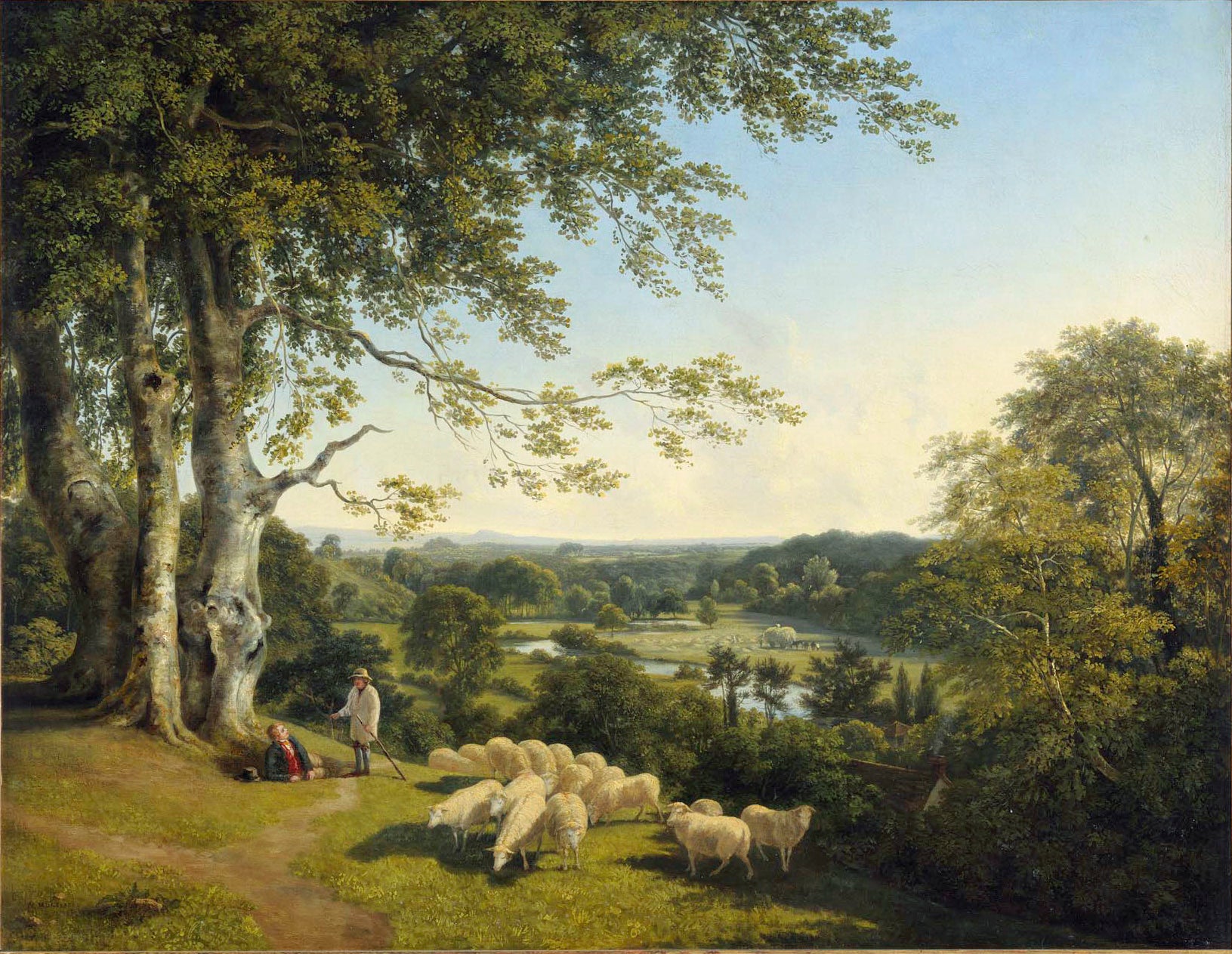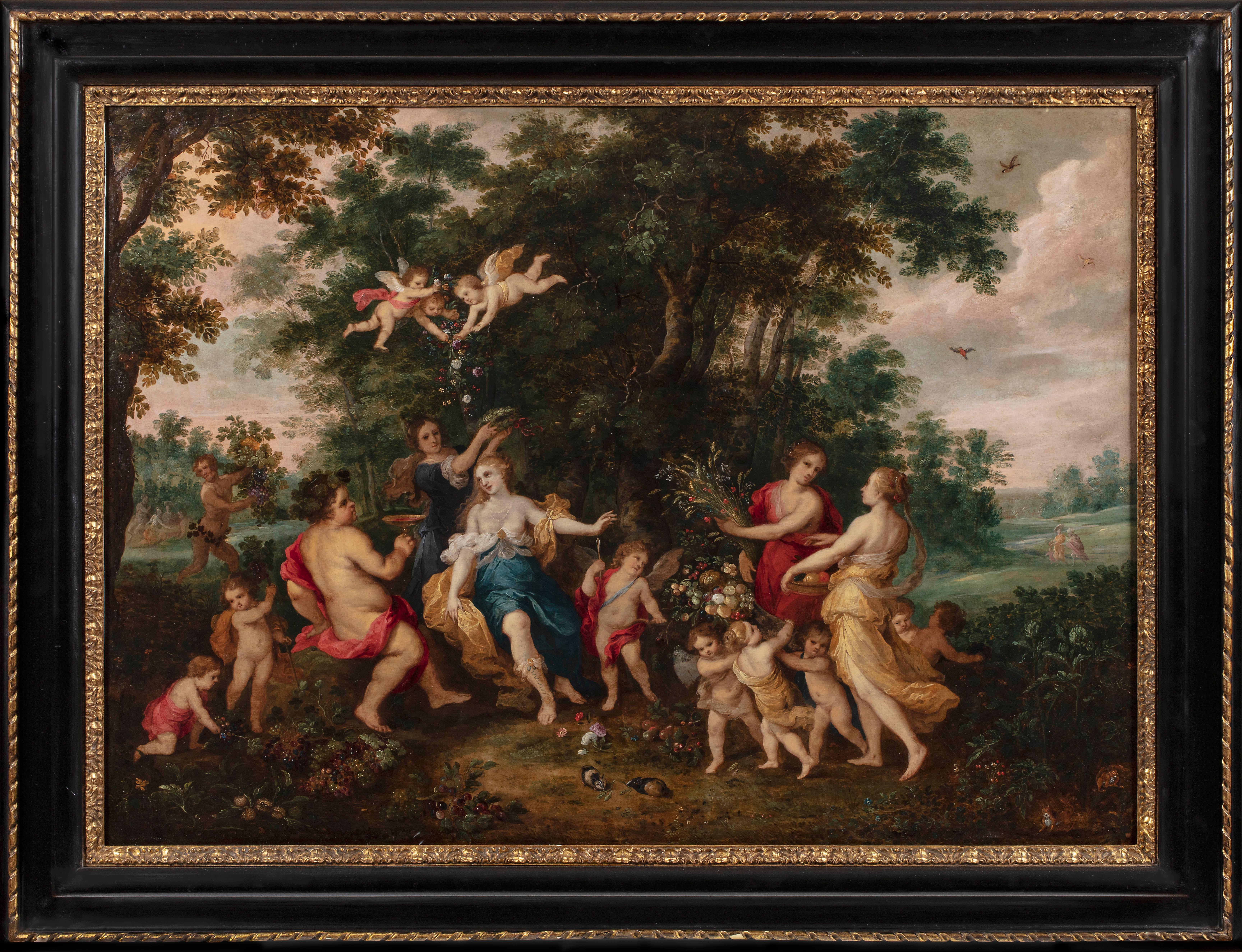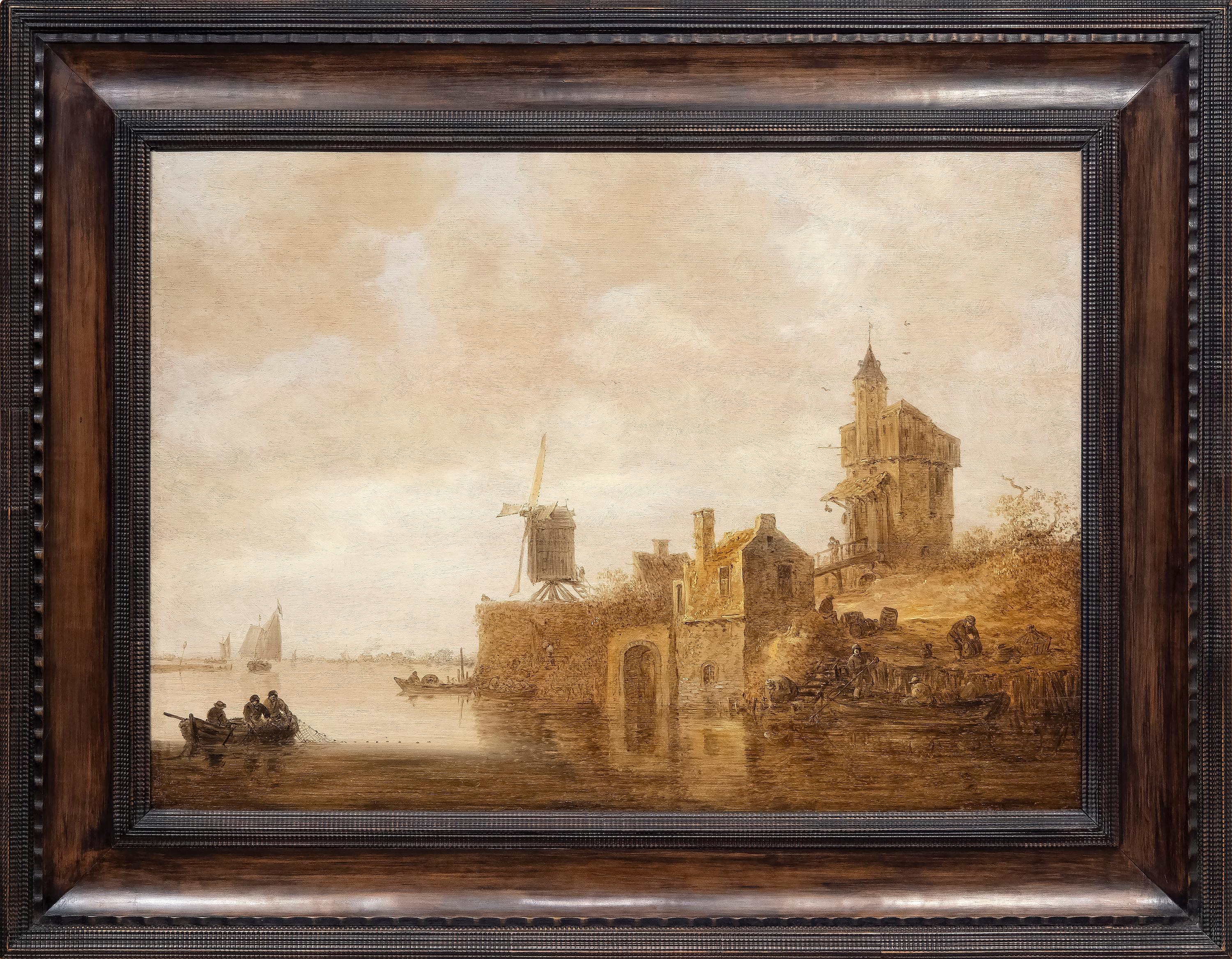Items Similar to Shipping in choppy waters of a coastline
Want more images or videos?
Request additional images or videos from the seller
Thomas ButtersworthShipping in choppy waters of a coastline
About the Item
Thomas Buttersworth (1768-1842)
Shipping in choppy coastal waters
signed and dated lower left
Oil on canvas
Canvas Size - 9 x 12 1/2 in
Framed Size - 13 x 16 1/2
Immerse yourself in the vibrant maritime art with Thomas Buttersworth, a luminary whose brushstrokes brought the majesty of the sea to life. Born in 1768, Buttersworth's journey began in London, where he honed his artistic prowess amidst the bustling docks and bustling maritime activities of the 18th century.
With an innate talent for capturing the drama and dynamism of naval scenes, Buttersworth swiftly gained recognition for his remarkable ability to infuse his paintings with a sense of realism and grandeur. His works not only depicted the technical intricacies of sailing vessels but also evoked the spirit of adventure and exploration that defined the maritime era.
Buttersworth's oeuvre encompasses a wide array of subjects, from majestic naval battles to serene harbor scenes bathed in golden light. His meticulous attention to detail and masterful use of light and shadow imbue each composition with a sense of authenticity and narrative depth, inviting viewers to embark on a journey through history.
Throughout his career, Buttersworth's paintings found favor among naval officers, merchants, and admirers of maritime art alike. His works adorned the walls of prestigious galleries and private collections, earning him widespread acclaim and cementing his legacy as one of the foremost marine painters of his time.
Today, the legacy of Thomas Buttersworth endures, captivating audiences with its timeless beauty and historical significance. His paintings continue to serve as windows to the past, offering a glimpse into an era defined by exploration, trade, and the relentless power of the sea.
Experience the awe-inspiring mastery of Thomas Buttersworth and embark on a voyage through the enchanting world of maritime art—a world where history and imagination converge to create timeless masterpieces.
- Creator:Thomas Buttersworth (1768 - 1842, English)
- Dimensions:Height: 13 in (33.02 cm)Width: 16.5 in (41.91 cm)
- Medium:
- Movement & Style:
- Period:
- Condition:
- Gallery Location:Stoke, GB
- Reference Number:1stDibs: LU446314237112

About the Seller
5.0
Recognized Seller
These prestigious sellers are industry leaders and represent the highest echelon for item quality and design.
Platinum Seller
These expertly vetted sellers are 1stDibs' most experienced sellers and are rated highest by our customers.
Established in 2009
1stDibs seller since 2016
146 sales on 1stDibs
Typical response time: 3 hours
Associations
LAPADA - The Association of Arts & Antiques DealersInternational Confederation of Art and Antique Dealers' AssociationsThe British Antique Dealers' Association
- ShippingRetrieving quote...Ships From: Andover, United Kingdom
- Return PolicyA return for this item may be initiated within 2 days of delivery.
More From This SellerView All
- View of Shipping on the River Avon from Durdham Down, near BristolLocated in Stoke, HampshireThomas Smith of Derby (c. 1710-1767) View of Shipping on the River Avon from Durdham Down, near Bristol, 1756 Oil on canvas Canvas size - 20 x 47 in Framed size - 26 x 53 in Provena...Category
18th Century Old Masters Landscape Paintings
MaterialsOil
- Fisherfolk unloading the days catchBy John Thomas SerresLocated in Stoke, HampshireJohn Thomas Serres (1759-1825) Fisherfolk unloading the days catch Oil on canvas Canvas Size - 17 x 25 in Framed Size - 22 x 30 in John Thomas Serres, a luminary in the realm of mar...Category
18th Century Old Masters Landscape Paintings
MaterialsOil
- A view at TivoliLocated in Stoke, HampshireJohn Rathbone (1750-1807) View at Tivoli Signed lower right Oil on Canvas Canvas size - 18 x 24 in Framed size - 24 x 30 in John Rathbone was born in Cheshire in 1750 and worked as ...Category
18th Century Old Masters Landscape Paintings
MaterialsOil
- A large wooded river landscape with droversBy Benjamin Barker of BathLocated in Stoke, HampshireBenjamin Barker of Bath (Pontypool 1776-1838) A wooded river landscape with drovers Signed and dated 'B.Barker pinxt/ 1807' lower right Oil on canvas 46 x 68 3/4 in (116.8 x 174.5 cm...Category
18th Century Old Masters Landscape Paintings
MaterialsOil
- 'Prime Minister' with jockey John Shepherd up, and owner Sir Mark SykesBy Henry Bernard ChalonLocated in Stoke, HampshireHenry Bernard Chalon (London 1770-1849) 'Prime Minister' with jockey John Shepherd up, and owner Sir Mark Sykes Signed and dated 'H.B. Chalon pinxit 181...Category
Early 19th Century Old Masters Animal Paintings
MaterialsOil
- Figures resting by a fire with a wagon in a wooded landscapeBy Benjamin Barker of BathLocated in Stoke, HampshireBenjamin Barker of Bath (Pontypool 1776-1838) Figures resting by a fire with a wagon in a wooded landscape Oil on canvas 28 x 35 7/8 in 71.1 x 91.2 cm Benjamin Barker, the younger ...Category
18th Century Old Masters Landscape Paintings
MaterialsOil
You May Also Like
- Grand 19th Century English Marine Painting in Stunning LightBy John Wilson EwbankLocated in London, GBJohn Wilson Ewbank (1799 - 1847) Shipping in the Harbour, South Shields Oil on canvas 39.5 x 58 inches unframed 47.75 x 66.5 inches framed Provenance: Christie's October 2002; Lot 11. Fine Art Society; Private Collection This marvellous up to scale Ewbank is full of light and warmth and almost certainly his greatest work of the sort rarely - if ever - seen on the market. John W. Ewbank (4 May 1799–28 November 1847), was an English-born landscape and marine painter largely operational from Scotland. The Humber river is a large tidal estuary on the east coast of Northern England. Life Ewbank was born at Darlington on 4 May 1799, the son of Michael Ewbank, an innkeeper. He was adopted as a child by a wealthy uncle who lived at Wycliffe, on the banks of the River Tees, in the North Riding of Yorkshire. Intended for the Roman Catholic priesthood, he was sent to Ushaw College, from which he absconded. In 1813 Ewbank was apprenticed to Thomas Coulson, an ornamental painter in Newcastle. In around 1816 he moved with Coulson to Edinburgh, where he had some lessons with Alexander Nasmyth. He found work both as a painter and a teacher. He was nominated in 1830 one of the foundation members of the Royal Scottish Academy. In 1833 he is listed as living at 7 Union Street on the eastern fringe of the New Town in Edinburgh. Works His sketches from nature were especially admired, and a series of 51 drawings of Edinburgh by him were engraved by W. H. Lizars for James Browne's Picturesque Views of Edinburgh (1825). He also made a reputation with cabinet pictures of banks of rivers, coast scenes, and marine subjects. As an illustrator he illustrated some early editions of Scott's Waverley Novels and one edition of Gilbert White...Category
19th Century Old Masters Figurative Paintings
MaterialsOil
- Important 18th Century Royal Academy Old Master Oil Painting of Georgian LondonLocated in Gerrards Cross, GB‘St. James’ Day’ by Richard Morton Paye (1750-1820). This very large and important 18th century oil on canvas depicts a diverse crowd of Londoners at an oyster stand on a summer’s ev...Category
1780s Old Masters Figurative Paintings
MaterialsOil
- Allegory of AbundanceLocated in New York, NYPainted in collaboration with Hendrick van Balen (Antwerp, 1575 – 1632). Provenance: Private Collection, Uruguay, since the 1930s. The eldest son of Jan Br...Category
17th Century Old Masters Paintings
MaterialsCopper
- A WolfLocated in New York, NYProvenance: The Marchesi Strozzi, Palazzo Strozzi, Florence Sale, Christie’s, London, May 20, 1993, lot 315, as by Carl Borromaus Andreas Ruthart...Category
17th Century Old Masters Animal Paintings
MaterialsPaper, Canvas, Oil
- River Landscape with a Windmill and ChapelBy Jan Josefsz Van GoyenLocated in Palm Desert, CA"River Landscape with a Windmill and Chapel" is a painting by Dutch Old Master Painter, Jan van Goyen. There are traces of a signature on the bow of the boat...Category
1640s Old Masters Landscape Paintings
MaterialsPanel, Oil
- Early oil depicting the Great Fire of LondonLocated in London, GBThe Great Fire of London in September 1666 was one of the greatest disasters in the city’s history. The City, with its wooden houses crowded together in narrow streets, was a natural fire risk, and predictions that London would burn down became a shocking reality. The fire began in a bakery in Pudding Lane, an area near the Thames teeming with warehouses and shops full of flammable materials, such as timber, oil, coal, pitch and turpentine. Inevitably the fire spread rapidly from this area into the City. Our painting depicts the impact of the fire on those who were caught in it and creates a very dramatic impression of what the fire was like. Closer inspection reveals a scene of chaos and panic with people running out of the gates. It shows Cripplegate in the north of the City, with St Giles without Cripplegate to its left, in flames (on the site of the present day Barbican). The painting probably represents the fire on the night of Tuesday 4 September, when four-fifths of the City was burning at once, including St Paul's Cathedral. Old St Paul’s can be seen to the right of the canvas, the medieval church with its thick stone walls, was considered a place of safety, but the building was covered in wooden scaffolding as it was in the midst of being restored by the then little known architect, Christopher Wren and caught fire. Our painting seems to depict a specific moment on the Tuesday night when the lead on St Paul’s caught fire and, as the diarist John Evelyn described: ‘the stones of Paul’s flew like grenades, the melting lead running down the streets in a stream and the very pavements glowing with the firey redness, so as no horse, nor man, was able to tread on them.’ Although the loss of life was minimal, some accounts record only sixteen perished, the magnitude of the property loss was shocking – some four hundred and thirty acres, about eighty per cent of the City proper was destroyed, including over thirteen thousand houses, eighty-nine churches, and fifty-two Guild Halls. Thousands were homeless and financially ruined. The Great Fire, and the subsequent fire of 1676, which destroyed over six hundred houses south of the Thames, changed the appearance of London forever. The one constructive outcome of the Great Fire was that the plague, which had devastated the population of London since 1665, diminished greatly, due to the mass death of the plague-carrying rats in the blaze. The fire was widely reported in eyewitness accounts, newspapers, letters and diaries. Samuel Pepys recorded climbing the steeple of Barking Church from which he viewed the destroyed City: ‘the saddest sight of desolation that I ever saw.’ There was an official enquiry into the causes of the fire, petitions to the King and Lord Mayor to rebuild, new legislation and building Acts. Naturally, the fire became a dramatic and extremely popular subject for painters and engravers. A group of works relatively closely related to the present picture have been traditionally ascribed to Jan Griffier...Category
17th Century Old Masters Landscape Paintings
MaterialsCanvas, Oil




